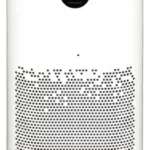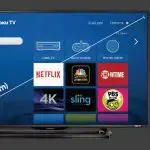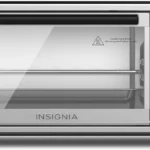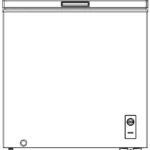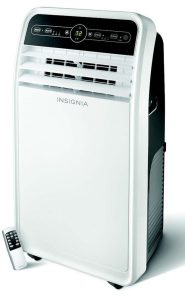

INSIGNIA NS-AC10PWH9 Portable Air Conditioner
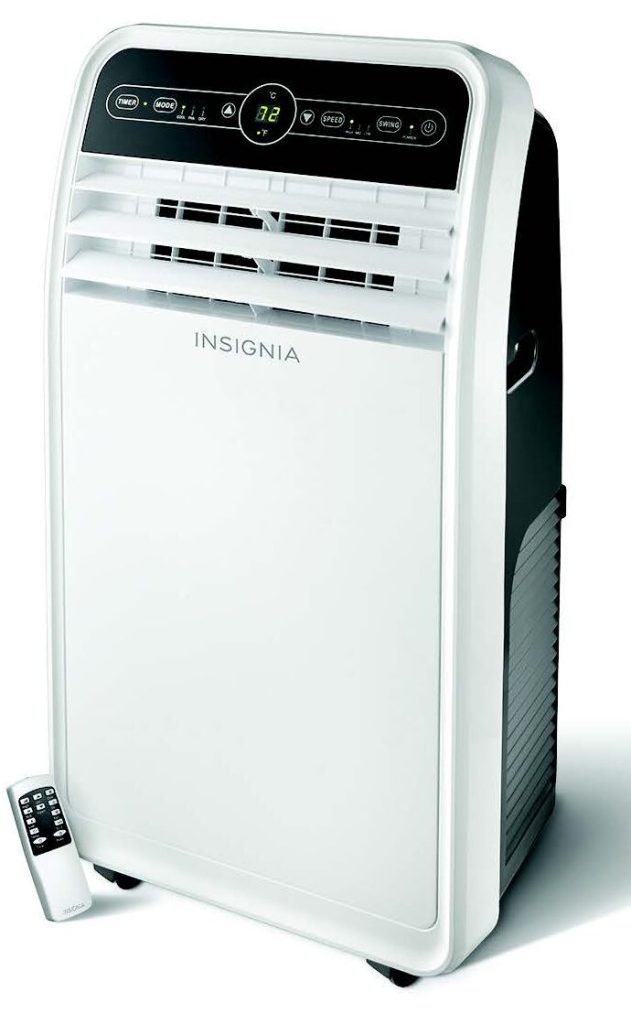
INSIGNIA NS-AC10PWH9 Portable Air Conditioner
Introduction
Congratulations on your purchase of a high-quality Insignia product. Your NS-AC10PWH9 / NS-AC12PWH9 /NS-AC10PWH9-C / NS-AC12PWH9-C represents state of the art design in portable air conditioning, designed for reliable and trouble-free performance.
IMPORTANT SAFETY INSTRUCTIONS
CAUTION
RISK OF ELECTRIC
SHOCK
DO NOT OPEN
This symbol indicates that dangerous voltage constituting a risk of electric shock is present within your portable air conditioner
This symbol indicates that there are important operating and maintenance instructions in the literature accompanying your portable air conditioner.
WARNING
- Read these instructions.
- Keep these instructions.
- Heed all warnings.
- Follow all instructions.
- Do not use this machine near water.
- Clean only with a damp cloth.
- Do not block any ventilation openings. Install in accordance with the manufacturer’s instructions.
- Do not install near any heat sources such as radiators, heat registers, stoves, or other apparatus (including amplifiers) that produce heat.
- Do not defeat the safety purpose of the polarized or grounding-type plug. A polarized plug has two blades with one wider than the other. A grounding-type plug has two blades and a third grounding prong. The wide blade or the third prong are provided for your safety. If the provided plug does not fit into your outlet, consult an electrician for replacement of the obsolete outlet.
- Protect the power cord from being walked on or pinched particularly at plugs, convenience receptacles, and the point where they exit from the machine.
- Do not attempt to modify or extend the power cord of this machine.
- Unplug this machine during lightning storms or when it will not be used for long periods of time.
- Make sure that the available AC power matches the voltage requirements of this machine.
- Do not handle the plug with wet hands. This could result in an electric shock.
- Unplug the power cord by holding the plug, never by pulling the cord.
- Do not turn the machine on or off by plugging or unplugging the power cord.
- Turn off the machine before unplugging it.
- Refer all servicing to qualified service personnel. Servicing is required when the machine has been damaged in any way, such as power-supply cord or plug is damaged, liquid has been spilled or objects have fallen into the machine, the machine has been exposed to rain or moisture, does not operate normally, or has been dropped.
- To reduce the risk of fire or electric shock, do not expose this machine to rain, moisture, dripping, or splashing, and no objects filled with liquids should be placed on top of it.
- Batteries should not be exposed to excessive heat such as sunshine, fire, or the like.
Caution: Danger of explosion if batteries are incorrectly replaced. Replace only with the same or equivalent type.
Additional precautions
- This machine is intended for household use. Do not use for any other purpose.
- Use this machine indoors in a dry location only. Do not use it outdoors.
- Do not place heavy objects on the machine, as this could damage the machine.
- Wipe the machine with a soft cloth to clean it. Do not use wax, thinner, or irritating detergents.
- Do not allow children or pets to drink the water discharged by the machine.
- Do not disassemble or attempt to repair the machine yourself.
- Do not plug this machine into an outlet with several other high electrical usage appliances.
- Keep the machine away from heat sources and avoid direct sunlight.
- If the machine is making a loud noise or producing an odor or smoke, switch it off, disconnect the plug, and immediately try to determine the cause.
- Do not place heavy objects on the power cord to avoid it being crushed and causing an electric shock.
- Do not put your fingers or hard objects into the outlet air guide bars.
- Turn the machine off and unplug it if there is water inside the machine, then contact qualified service personnel for servicing.
- Turn the machine off and unplug it before cleaning, moving, or servicing it.
- To avoid injury, do not allow children or other individuals with special needs to touch or operate the machine. The machine should only be used with adult supervision.
- Place the air conditioner on a flat surface and upright to ensure the normal operation of the compressor.
- Do not use the machine near gasoline or other flammable liquids.
- Do not use aerosol sprays or other solvents near the machine. This may cause plastic deformation or possibly damage the electrical components of the machine.
WARNING
Electric Shock Hazard
Failure to follow these instructions can result in electric shock, fire, or death.
- This unit must be properly grounded.
- Do not, under any circumstances, cut or remove the grounding plug.
- If you do not have a properly grounded AC outlet, or if there is any doubt that the outlet is not properly grounded, a qualified electrician should check the outlet and circuit and, if necessary, install a properly grounded outlet.
- This air conditioner must be plugged into a grounded 115V, 60 Hz AC outlet, protected by a 15 amp time-delay fuse or circuit breaker.
- This air conditioner must be installed in accordance with national wiring codes.
- Do not alter or modify the plug or cord of this air conditioner. If the power cord becomes worn or damaged, the cord should only be replaced by a qualified service technician using genuine replacement parts.
- Do not use an extension cord
Electrical Safety
Integrated circuit breaker
For additional safety, the power cord on this air conditioner features an integrated circuit breaker. You can test and reset the circuit breaker using the buttons provided on the plug case.
Preferred grounding method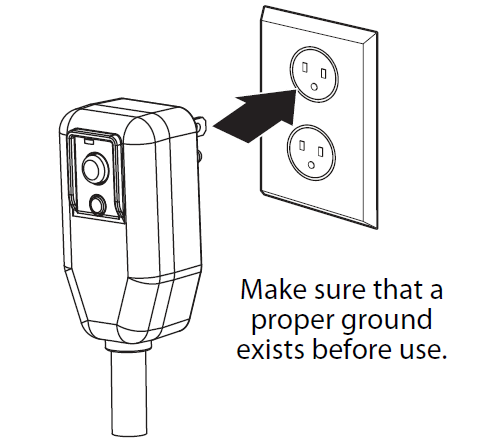
Temporary grounding
Due to potential safety hazards, we strongly discourage the use of an adapter plug. If an adapter plug must be used for a temporary connection, use only a UL-listed adapter with a minimum capacity of 120V~60Hz, 13A, and 1560W. Make sure that the large slot of the adapter is aligned with the large slot in the outlet.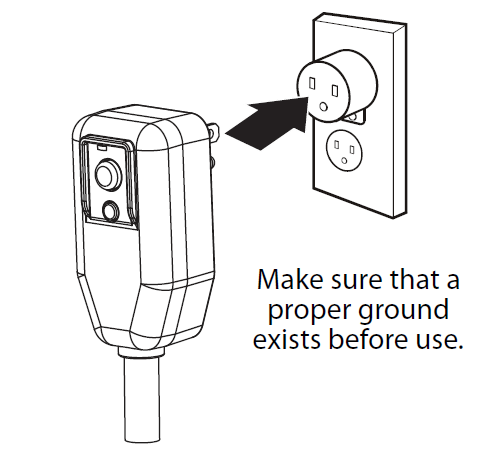
To prevent damage to the adapter’s ground terminal, hold the adapter in place while plugging or unplugging the air conditioner.
Attaching the adapter ground terminal to the wall receptacle cover screw does not ground the appliance unless the cover screw is metal and not insulated and the wall receptacle is grounded through the house wiring.
Frequent connection and disconnection can damage the ground terminal on the adapter. Never use a broken or damaged adapter.
Features
- 3-in-1 design (air conditioner, fan, and dehumidifier)
- Digital controls with LED display
- Multiple fan speeds with auto-control
- Programmable timer and remote control
- Auto On/Off
Package contents
- Exhaust hose with adapter
- Window sealing plate assembly (window sealing plates [2], security bracket, and four screws [two type A, one type B, and one type C])
- Remote control (with two AAA batteries)
- Quick Setup Guide
- Sealing gaskets (2)
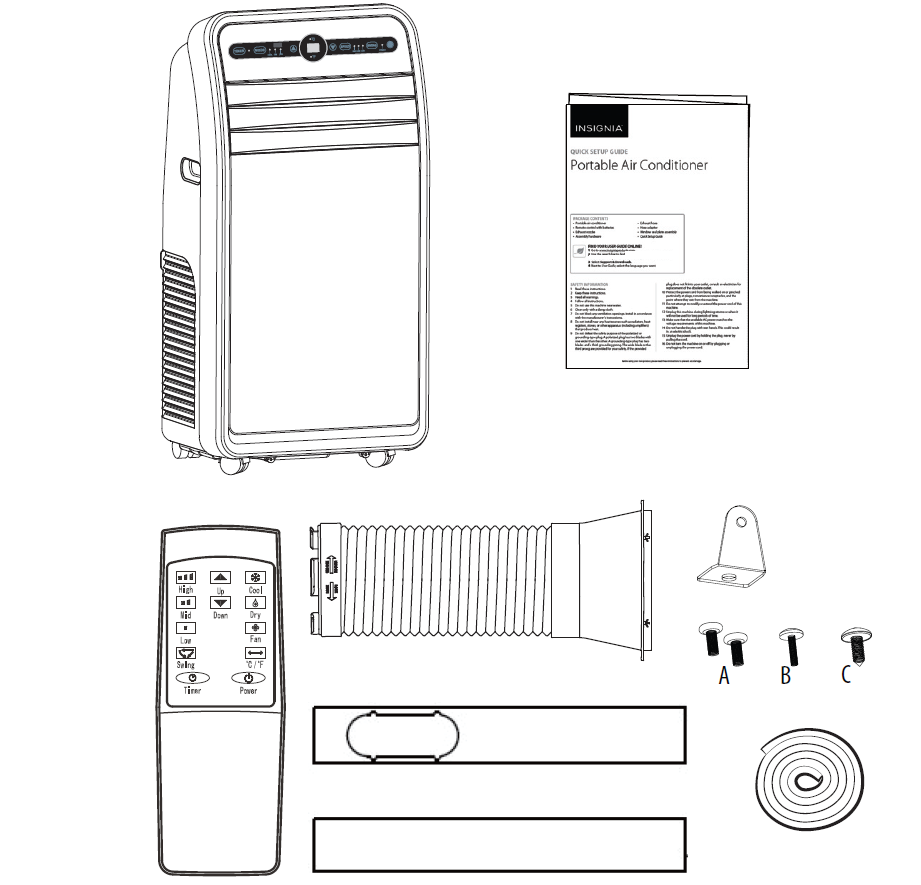
Main components
Front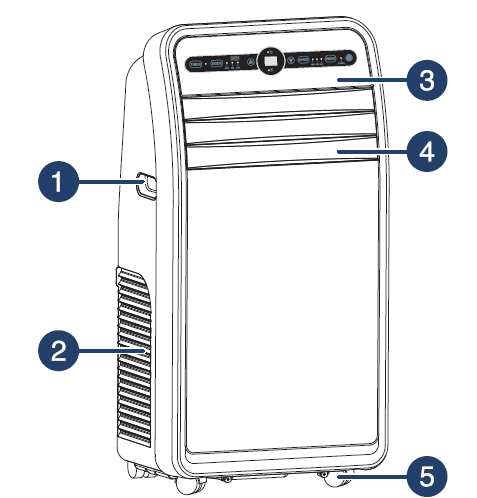
| # | ITEM | DESCRIPTION |
| 1 | Handle | Provides a convenient grip when moving your air conditioner. |
| 2 | Air inlet | Allows air to enter the air conditioner. Do not block. |
| 3 | Control panel and display | Displays air conditioner settings. Press the buttons to change settings. |
| 4 | Adjustable louvered air discharge | Opens automatically when the air conditioner is turned on. Can also be set to oscillate. |
| 5 | Swiveling casters | Allows you to move the air conditioner easily on most surfaces. |
Back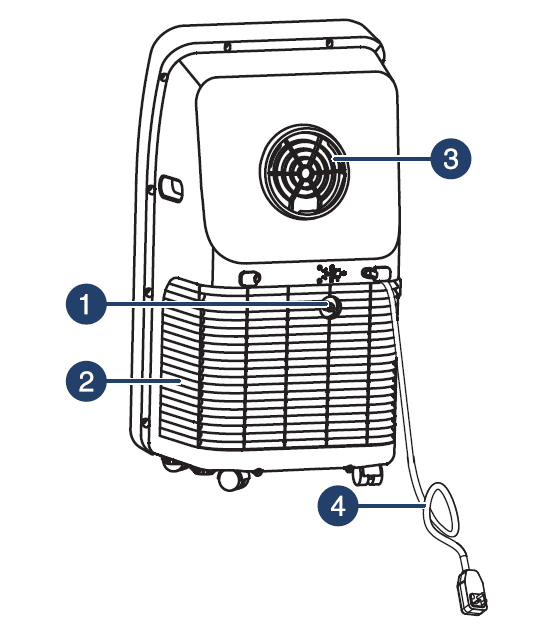
Control panel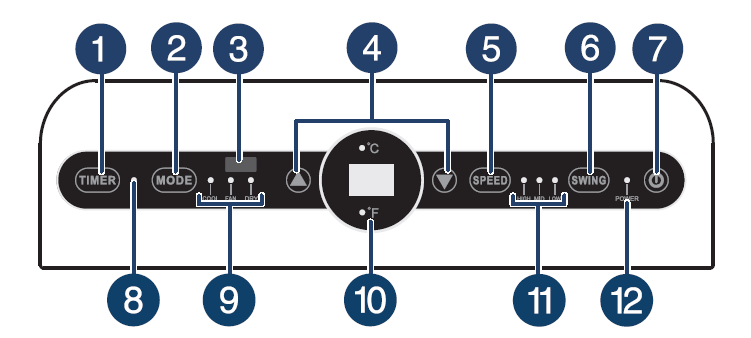
| # | ITEM | DESCRIPTION |
| 1 | TIMER button | Press to set the air conditioner to turn on or off automatically. |
| 2 | MODE button | Press to cycle the air conditioner through the available modes. Options include COOL, FAN, and DRY. |
| 3 | Remote control receiver | Receives signals from the remote control. Do not block. |
|
4 |
up and down (TEMP/TIMER)
buttons |
COOLING mode: Press to raise or lower the temperature setting. Press at the same time to change from Fahrenheit to Celsius.
TIMER mode: Press to increase or decrease the time. |
| 5 | SPEED button | Press to select high, mid, or low speed. |
| 6 | SWING button | Press to turn oscillation on or off. |
| 7 | Power button | Press to turn the air conditioner on or off. |
| 8 | Timer indicator | Lights when the timer is turned on. |
| 9 | Mode indicators | Light to show the air conditioner mode. |
| 10 | LED display Temperature/Time display | Shows the temperature and time left on the timer. |
| 11 | Fan speed indicators | Light to show the fan’s speed. |
| 12 | Power indicator | Lights when the air conditioner is turned on. |
Accessories
| # | ITEM | DESCRIPTION |
| 1 | Exhaust hose and adapter | Connects the air conditioner to the window installation kit to vent exhaust air outside. |
| 2 | Window sealing plate assembly | Lets you route the air conditioner exhaust through a vertical or horizontal window opening and seal your window at the correct height/width. |
| 3 | Remote control | Use to control the air conditioner remotely. |
| 4 | Window security bracket | Used to hold the window in place with the seal plate installed. |
| 5 | Screws A (2) | Use one screw to secure the window sealing plate (the second screw is a spare). |
| 6 | Screw B | Use to secure the hose adapter to the window sealing plate. |
| 7 | Screw C | Use to hold the window security bracket in place. |
| 8 | Sealing gaskets (2) | Use to seal the window to prevent warm air from entering the room. |
Remote control
| # | ITEM | DESCRIPTION |
| 1 | Speed settings | Press to raise or lower the fan speed. |
| 2 | Swing button | Press to turn oscillation on or off. |
| 3 | Timer | Press to set the air conditioner to turn on or off automatically. |
|
4 |
(up) and
(down) buttons |
In cool or fan mode, press to raise (p) or lower (q) the temperature setting.
In timing mode, press to increase or decrease the time. |
| 5 | Cool button | Press to set the air conditioner to cooling mode. |
| 6 | Dry button | Press to turn on the dehumidifier only (no cooling). |
| 7 | Fan button | Press to turn on the fan only (no cooling). |
| 8 | °C / °F button | Press to switch between Fahrenheit and Celsius. |
| 9 | Power button | Press to turn the air conditioner on or off. |
Setting up your portable air conditioner
Remove and store (optional) packing materials for reuse. Remove any shipping tape before using the air conditioner.
Remove tape residue with liquid dish soap and a damp cloth. Do not use sharp tools, alcohol, thinners, or abrasive cleaners to remove adhesive, which could damage the finish.
Notes:
- Do not remain in the direct airflow from the air conditioner for extended periods.
- When used at the same time as stoves, fireplaces, or other combustion/heating devices, make sure that there is sufficient flow of fresh air into the room. Do not use in tightly closed spaces with these types of devices.
- This air conditioner is intended for household use as a consumer comfort appliance. Do not use it as a precision climate control system for the purpose of cooling precision equipment, food, pets, plants, artwork, and so on. Such items could be damaged.
- Do not bend the hose downward when the window installation kit is not being used. Doing so may cause inferior performance or failure of the air conditioner.
Placing your air conditioner
Place the unit on a flat, dry area near a window, so you can use the hose and adapter to connect the air conditioner to the window installation kit in order to vent the exhaust air outside.
To maintain good air circulation and optimum machine performance, leave a 20 in. (50 cm) space around it.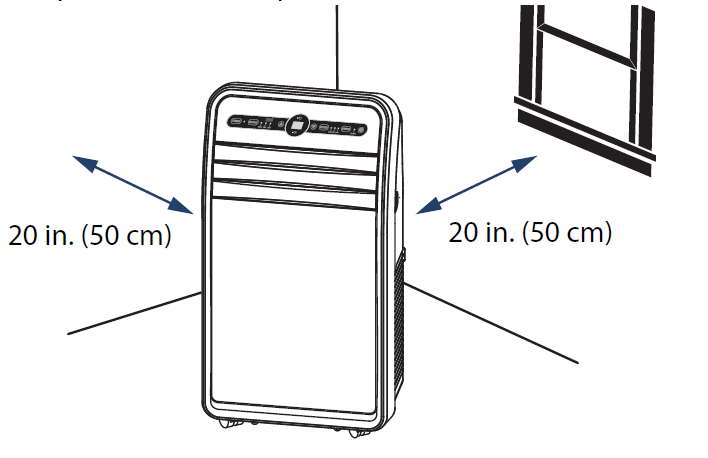
Installing your air conditioner
- Screw the exhaust hose to the exhaust outlet on the back of your air conditioner, then screw the hose adapter to the other end of the hose.
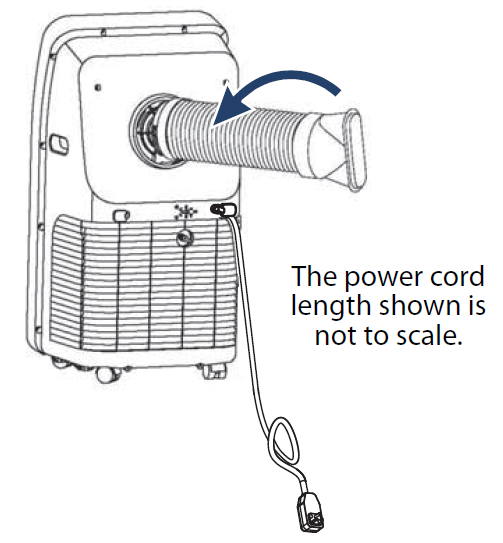
- Measure the window size.
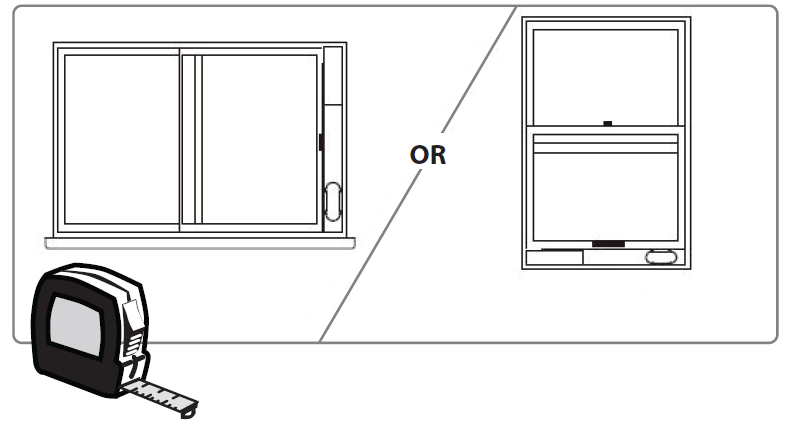
- Install the window sealing plate in the window opening, adjusting the length to fit the window opening and securing it with screw A (provided).
Note:- The window sealing kit works with sliding and vertical, double-hung windows.
- You do not need to remove your window screen.
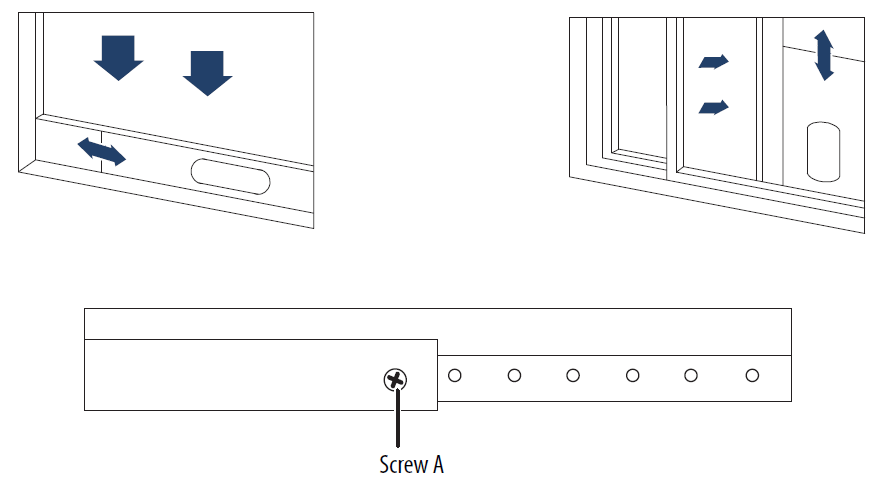
- Insert the hose adapter into the vent panel, then slide the adapter until it clicks into place.
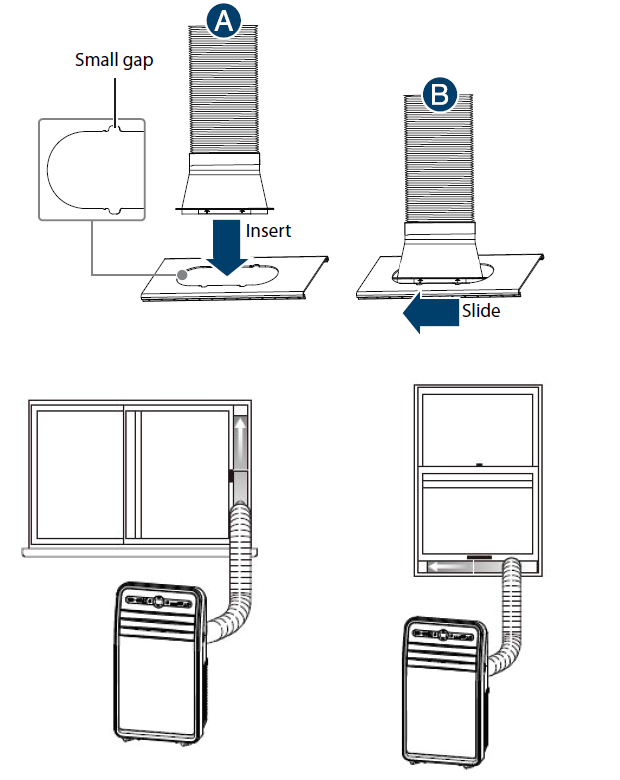
- (Optional) Secure the hose adapter to the vent panel with the type B screw (provided).

- For optimum performance, do not twist the venting hose. For better efficiency, shorten the hose by squeezing its sections together.

- For optimum performance, do not twist the venting hose. For better efficiency, shorten the hose by squeezing its sections together.
- (Optional) Install the security bracket with the type C screw (provided).
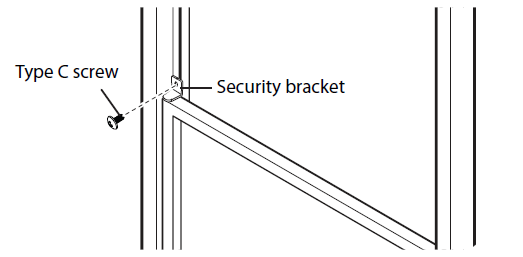
- (Optional) To set up your air conditioner to automatically drain water while using the dehumidifier, see “Automatically drain water with a hose” on page 16.
- (Optional) Remove the sealing gaskets (two 60″ rolls) from the accessory bag.
- Remove the paper on the sealing gasket to expose the adhesive, then stick the sealing gasket to the edges of the window to prevent warm air from entering the room when mounted.
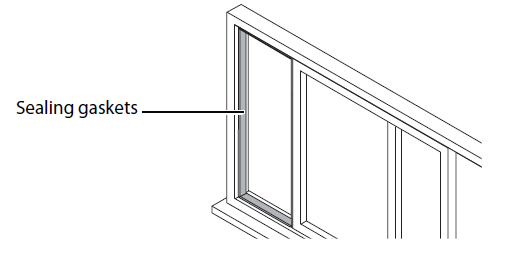
- Adjust the sealing plate to fit the opening, then install the sealing plate.
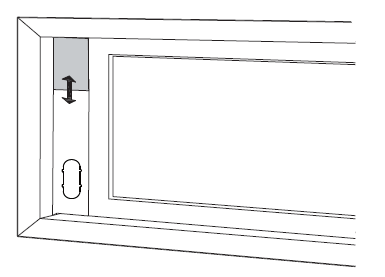
Using your portable air conditioner
Inserting the batteries in the remote control
- Press down on the arrow on the back of the remote control, then slide the battery cover from the battery compartment.
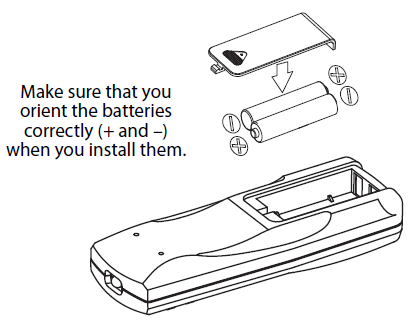
- Insert two AAA batteries (provided) into the battery compartment. Note the proper orientation of the + and – polarity of the batteries.
- Reinstall the battery compartment cover, making sure the tab locks into place.
Notes:- Use only carbon-zinc or alkaline batteries. Do not use rechargeable batteries.
- When you replace the batteries, always replace them with new batteries. Do not mix old and new batteries.
- If your air conditioner will not be used for an extended period of time, remove the batteries from the remote control.
Cautions: - If the fluid from inside the batteries comes into contact with your skin or clothes, wash immediately with clean water.
- Do not use the remote control if the batteries are leaking.
- If the fluid from inside the batteries gets into your mouth or eyes, flush immediately with clean water and contact a doctor for treatment.
Using the air conditioner
You can control your air conditioner by using the control panel on the front of the unit, or by using the remote control. If using the remote control, always point it at the air conditioner.
| BUTTON | DESCRIPTION |
| POWER BUTTON | Press to turn your air conditioner on or off:
• When you turn the air conditioner on, you will hear a tone and the air discharge automatically opens. • When you turn your air conditioner off, you will hear a tone and the air discharge closes. Control settings, such as Mode, Set Temperature, and so on, are retained in memory when the power is off (unless the unit has been unplugged). |
| MODE | Press to cycle through the operating modes (COOL, FAN, or DRY):
• COOL: The compressor runs and cools the room. Use the p or q and SPEED buttons to set the desired temperature and fan speed. • FAN: The fan circulates the air, but the compressor does not run to cool it. Use the SPEED button to set the desired fan speed. • DRY: The dehumidifier runs to remove humidity from the air. After the ambient temperature is reached the compressor turns off. The fan speed is preset and cannot be adjusted. We recommend that you use a drain hose in dry mode (see “Using your portable air conditioner” on page 13 for instructions). Note: The LED next to the Mode button displays the active mode. The default mode is COOL. |
| SPEED | Cycles through the available fan speeds. The LED next to the SPEED button displays the fan speed. The speed can be selected in either the COOL or FAN modes. |
| UP AND DOWN | • COOL mode: Press to adjust the temperature setting up to 86°F (30°C) or down to 60°F (16°C), in one degree increments. The temperature can be switched between Fahrenheit and Celsius by pressing p and q at the same time, or by pressing the °C/°F switching button on the remote control.
Note: In fan and dry modes, the temperature displayed is the room temperature (not the set temperature). In COOL mode, the thermostat in the air conditioner runs the compressor until the set temperature is reached, then the compressor cycles on and off to maintain the set temperature. • TIMER mode: Press p or q to adjust the delay time from one to 24 hours, in one hour increments. If you press and hold p or q, the set temperature or time changes automatically. |
| TIMER | Press to set your air conditioner to turn off or turn on after a delay of up to 24 hours.
• Automatic off: Press p or q while the air conditioner is running to set the delay time from one to 24 hours, in one hour increments. The air conditioner automatically turns off when the set delay time is reached. • Automatic on: Press p or q while the air conditioner is off to set the delay time from one to 24 hours, in one hour increments. The air conditioner automatically turns on when the set delay time is reached. Press the TIMER button to see the delay time you have set on the LED display. To change the set delay time (on or off): Press the TIMER button, then adjust the time with the p or q buttons when the number begins to blink. To cancel the Timer function: Press the TIMER button, then press it again when the number begins to blink. Note: Do not unplug the air conditioner while using the Timer function. After setting the Timer function, if you use the remote control to change to another mode without resetting the Timer function, the timer is reset. |
| SWING | Press to turn on the automatic oscillation, which varies the direction of the air flow to cool the room more efficiently. |
Cleaning and maintaining your air conditioner
Your air conditioner is designed for year-round use with only minimal cleaning and maintenance.
For maximum efficiency, we recommend that you have the cooling coils inspected and cleaned annually by a professional technician.
Warning:
- Unplug the air conditioner before cleaning or performing any maintenance or service.
- Be careful when cleaning coils or removing or reinstalling the filter. The cooling fins are very sharp.
- Failure to follow the above precautions could result in electric shock or personal injury.
Cleaning the case
- Wipe the case with a slightly damp cloth, then wipe dry with a dry cloth
Caution:
To prevent damage to the finish, do not use:
- Gasoline, benzine, thinner, or other similar solvents.
- Abrasive cleaners.
Never pour water onto or into the air conditioner. It could damage the internal components and create a shock or fire hazard.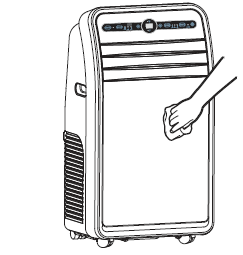
Cleaning the air filter
The air filter should be cleaned every two weeks. Depending on indoor air quality, the filter may require cleaning more often. A dirty air filter decreases the airflow and reduces the efficiency of the air conditioner.
Do not operate the air conditioner without the air filter in place.
- Lift the air filter out by the handle.
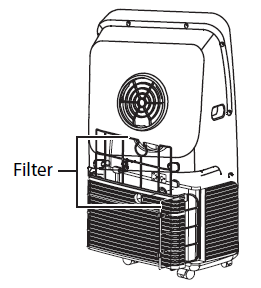
- Clean the filter with a vacuum cleaner. If the filter is very dirty, it can be washed by hand in warm water with a mild detergent.
Cautions:- Do not use harsh cleaners or very hot water.
- Do not wash in a dishwasher or washing machine.
- Let the filter dry completely, then reinstall it in the air conditioner.
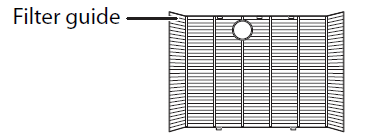
Emptying the water collection tank
When the internal water collection tank is full, “FL” appears on the LED display and your air conditioner turns off until the tank is emptied.
Notes:
- When operating or draining water from your air conditioner, always protect carpeting and floors from possible water spillage.
- When you drain the water from your air conditioner, be sure to wipe up any spilled water with a dry cloth or towel.
Manually drain water
- Unplug your air conditioner, then disconnect the exhaust hose from the back.
- Move your air conditioner to a location where a suitable drain is available or place a drain pan under the unit that is capable of holding up to 1.37 pints (0.65 liters) of water.
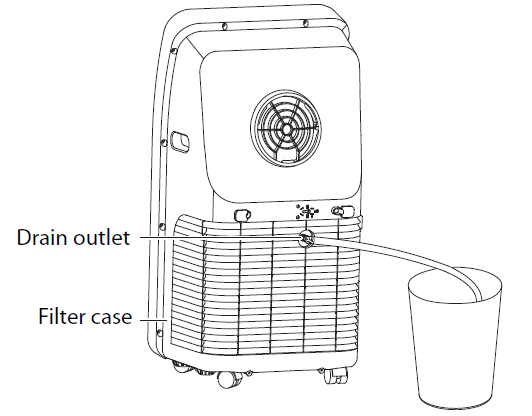
- Remove the rubber plug from the drain outlet and insert a syphon hose (not included) into the opening.
- Syphon the water from your air conditioner.
- After you have drained the water collection tank, replace the rubber plug, making sure that the bolt is secure.
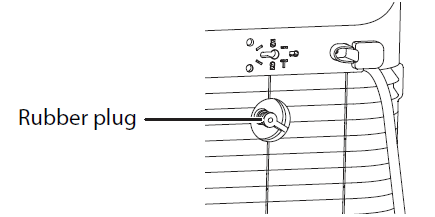
- Place the air conditioner in the desired location, reconnect the exhaust hose, then plug it in. When the air conditioner is restarted after being drained, it automatically starts in COOL mode with a temperature setting of 72°F.
Automatically drain water with a hose
Note: Drain your dehumidifer manually before connecting a drain hose. See “Manually drain water” on page 16
- Unplug your air conditioner and move it to a location where you can work on it.
- Remove the rubber plug from the unit.
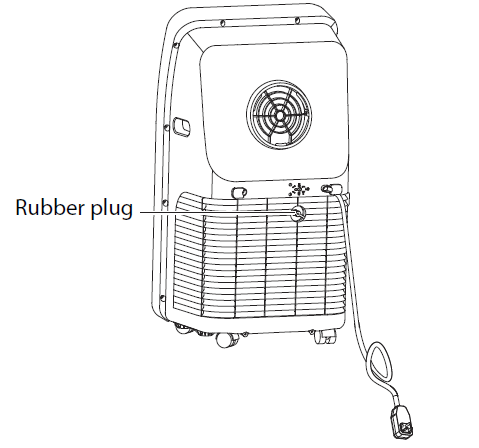
- Remove the filter case.
- Install a 0.47 in. (12 mm) inside diameter drain hose (not provided) on the back of the unit where you removed the water plug. Use a hose clamp (not provided) to make sure that there are no leaks.
- Replace the filter case.
- Place the open end of the hose in a suitable location to drain continuously.
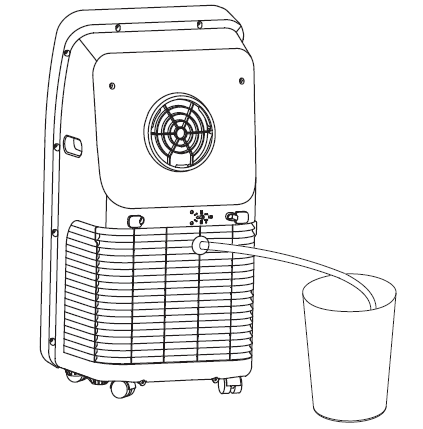
- Plug in your air conditioner and restart it.
- Set your air conditioner to DRY mode using either the remote control or the control panel.
Storing your air conditioner
If your air conditioner will not be used for an extended period of time, we suggest that you prepare it for storage by doing the following:
- Unplug your air conditioner.
- Remove the rubber plug and drain the water collection tank completely.
- Reinstall the rubber plug.
- Remove the filter case and clean the filter. Allow it to dry completely, then reinstall it.
- Remove the batteries from the remote control.
- Store the air conditioner in a cool, dry place, away from direct sunlight, extreme temperatures, and excessive dust.
Restarting your air conditioner after storage
- Make sure that the filter case and rubber plug are in place.
- Make sure that the power cord and plug are in good condition.
- Install new AAA batteries in the remote control.
- Move the air conditioner to the location where you plan to use it and reconnect the exhaust hose and electrical plug.
- Restart your air conditioner and make sure that everything runs smoothly.
Troubleshooting
Caution: Do not try to repair your portable air conditioner yourself. Doing so invalidates the warranty
| PROBLEM | POSSIBLE CAUSE | POSSIBLE SOLUTION |
|
Air conditioner does not start |
The air conditioner is unplugged. | Make sure that the air conditioner is plugged in and that the plug is pushed completely into the outlet. |
| The fuse on the circuit is blown or the circuit breaker is tripped. | Check the house fuse/circuit breaker box and replace the fuse or reset the circuit breaker. | |
|
Power failure. |
If a power failure occurs, the air conditioner turns off. When the power is restored, wait three minutes to restart the air conditioner to prevent tripping the compressor overload. | |
| The current interrupter device in the power cord has tripped. | Press the RESET button located on the power cord plug. If the RESET button will not stay engaged, discontinue use of the air conditioner and contact a qualified service technician. | |
| FL appears on the display. | The water collection tank is full and must be drained. Drain the tank and reset your settings. See “Emptying the water collection tank“ on page 16. | |
|
Room temperature is less than the set temperature. |
This is normal. The air conditioner automatically shuts off when the room temperature equals, or is less than, the set temperature. Adjust the temperature setting, if needed. | |
|
The air conditioner does not cool |
Airflow is restricted. | Make sure that there are no curtains, blinds, or furniture blocking the front of the air conditioner. |
| The temperature control may not be set correctly | In COOL mode, decrease the temperature setting by pressing the q button on the panel or the remote control. | |
| The air filter is dirty. | Clean the filter at lease every two weeks. See “Cleaning and maintaining your air conditioner” on page 15. | |
| The room may have been hot. | You need to allow time for the room to cool down after you first turn on the air conditioner. | |
| The exhaust hose is not connected or is blocked. | Connect the exhaust hose and make sure that it is not obstructed and is functioning properly. | |
| The air conditioner is freezing up | The cooling coils are iced over. | Ice may block the air flow and obstruct the air conditioner from properly cooling the room. Set the mode control to High Fan or High Cool. |
|
The air conditioner runs too often or too long |
The area to be cooled is too large for the air conditioner. | Contact Insignia Customer Care for the air conditioner capacity required to cool the desired area. |
| Doors or windows are open. | Make sure that doors and windows are closed. | |
| The venting hose is hot | When the air conditioner runs continuously for a long time, the hose becomes hot. | This is normal. |
|
The air conditioner is too loud |
The unit may seem rather loud for the first two or three minutes of operation. | This is the sound of the compressor starting up and is normal. |
| A soft, swishing noise can be heard immediately after turning the unit on or off, and during operation. |
This is the sound of the liquid refrigerant flowing in the unit and is normal. |
|
|
The air conditioner makes an odd noise |
An audible gurgling noise may be heard when the unit is operated on a gently sloping floor. |
Place the unit on a level floor. |
Intelligent error indication
If an E1, E2, or E4 error appears on the LED display, turn off your air conditioner and call a professional maintenance technician or service center.
| ERROR CODE | DESCRIPTION |
| E1 | Coil temperature sensor error. |
| E2 | Indoor temperature sensor error. |
| E4 | Anti-freezing protection. The air conditioner coil temperature is too low and the unit has turned off automatically. The unit resets itself when the temperature reaches 46.4°F (8°C). |
| FL | The internal water tank is full and needs to be emptied. |
Understanding your air conditioner’s automatic protection
Anti-freezing protection – When the ambient temperature is very low under Cooling mode, the compressor and motor will stop working for several minutes if the coil temperature is below 46.4°F (8°C). When the coil temperature increases to above 46.4°F (8°C), the protection turns off and the previous mode resumes. When anti-freezing protection is active, E4 appears on the display.
Water-full protection – When the water level in the bottom water pan exceeds the warning level, the unit will alert automatically, “FL” and “Water Full” will flash on the display. Turn off the air conditioner and drain the water as described in “Emptying the water collection tank” on page 16. After you have drained the water, restart your air conditioner.
Compressor delay protection – Except for the first power-on, the compressor can start instantly. In other cases, the compressor will start after three minutes delay protection.
Specifications
NS-AC10PWH9/NS-AC10PWH9-C
| Dimensions | 32.7 x 17.4 x 13.4 in (83 x 44.3 x 34 cm) |
| Weight | 55.1 lb. (25 kg) |
| Electrical requirements | 115V ~60 Hz |
| Power draw | 1.12 Kwh |
| Power cord length | 5.9 ft. (1.8 m) |
NS-AC12PWH9/NS-AC12PWH9-C
| Dimensions | 32.7 x 17.4 x 13.4 in (83 x 44.3 x 34 cm) |
| Weight | 61.7 lb. (28 kg) |
| Electrical requirements | 115V ~60 Hz |
| Power draw | 1.33 Kwh |
| Power cord length | 5.9 ft. (1.8 m) |
ONE-YEAR LIMITED WARRANTY
Definitions:
The Distributor* of Insignia branded products warrants to you, the original purchaser of this new Insignia-branded product (“Product”), that the Product shall be free of defects in the original manufacturer of the material or workmanship for a period of one (1) year from the date of your purchase of the Product (“Warranty Period”).
For this warranty to apply, your Product must be purchased in the United States or Canada from a Best Buy branded retail store or online at www.bestbuy.com or www.bestbuy.ca and is packaged with this warranty statement.
How long does the coverage last?
The Warranty Period lasts for 1 year (365 days) from the date you purchased the Product. Your purchase date is printed on the receipt you received with the Product.
What does this warranty cover? During the Warranty Period, if the original manufacture of the material or workmanship of the Product is determined to be defective by an authorized Insignia repair center or store personnel, Insignia will (at its sole option): (1) repair the Product with new or rebuilt parts; or (2) replace the Product at no charge with new or rebuilt comparable products or parts. Products and parts replaced under this warranty become the property of Insignia and are not returned to you. If service of Products or parts are required after the Warranty Period expires, you must pay all labor and parts charges. This warranty lasts as long as you own your Insignia Product during the Warranty Period. Warranty coverage terminates if you sell or otherwise transfer the Product.
How to obtain warranty service?
If you purchased the Product at a Best Buy retail store location or from a Best Buy online website (www.bestbuy.com or www.bestbuy.ca), please take
your original receipt and the Product to any Best Buy store. Make sure that you place the Product in its original packaging or packaging that provides the same amount of protection as the original packaging.
To obtain warranty service, in the United States and Canada call 1-877-467-4289. Call agents may diagnose and correct the issue over the phone.
Where is the warranty valid?
This warranty is valid only in the United States and Canada at Best Buy branded retail stores or websites to the original purchaser of the product in the country where the original purchase was made
What does the warranty not cover?
This warranty does not cover:
- Food loss/spoilage due to failure of refrigerator or freezer
- Customer instruction/education
- Installation
- Set up adjustments
- Cosmetic damage
- Damage due to weather, lightning, and other acts of God, such as power surges
- Accidental damage
- Misuse
- Abuse
- Negligence
- Commercial purposes/use, including but not limited to use in a place of business or in communal areas of a multiple dwelling condominium or apartment complex, or otherwise used in a place of other than a private home.
- Modification of any part of the Product, including the antenna
- Display panel damaged by static (non-moving) images applied for lengthy periods (burn-in).
- Damage due to incorrect operation or maintenance
- Connection to an incorrect voltage or power supply
- Attempted repair by any person not authorized by Insignia to service the Product
- Products sold “as is” or “with all faults”
- Consumables, including but not limited to batteries (i.e. AA, AAA, C etc.)
- Products where the factory applied serial number has been altered or removed
- Loss or Theft of this product or any part of the product
- Display panels containing up to three (3) pixel failures (dots that are dark or incorrectly illuminated) grouped in an area smaller than one tenth (1/10) of the display size or up to five (5) pixel failures throughout the display. (Pixel based displays may contain a limited number of pixels that may not function normally.)
- Failures or Damage caused by any contact including but not limited to liquids, gels or pastes.
REPAIR REPLACEMENT AS PROVIDED UNDER THIS WARRANTY IS YOUR EXCLUSIVE REMEDY FOR BREACH OF WARRANTY. INSIGNIA SHALL NOT BE LIABLE FOR ANY INCIDENTAL OR CONSEQUENTIAL DAMAGES FOR THE BREACH OF ANY EXPRESS OR IMPLIED WARRANTY ON THIS PRODUCT, INCLUDING, BUT NOT LIMITED TO, LOST DATA, LOSS OF USE OF YOUR PRODUCT, LOST BUSINESS OR LOST PROFITS. INSIGNIA PRODUCTS MAKES NO OTHER EXPRESS WARRANTIES WITH RESPECT TO THE PRODUCT, ALL EXPRESS AND IMPLIED WARRANTIES FOR THE PRODUCT, INCLUDING BUT NOT LIMITED TO ANY IMPLIED WARRANTIES OF AND CONDITIONS OF MERCHANTABILITY AND FITNESS FOR A PARTICULAR PURPOSE, ARE LIMITED IN DURATION TO THE WARRANTY PERIOD SET FORTH ABOVE AND NO WARRANTIES, WHETHER EXPRESS OR IMPLIED, WILL APPLY AFTER THE WARRANTY PERIOD. SOME STATES, PROVINCES AND JURISDICTIONS DO NOT ALLOW LIMITATIONS ON HOW LONG AN IMPLIED WARRANTY LASTS, SO THE ABOVE LIMITATION MAY NOT APPLY TO YOU. THIS WARRANTY GIVES YOU SPECIFIC LEGAL RIGHTS, AND YOU MAY ALSO HAVE OTHER RIGHTS, WHICH VARY FROM STATE TO STATE OR PROVINCE TO PROVINCE.
Contact Insignia:
1-877-467-4289
www.insigniaproducts.com
INSIGNIA is a trademark of Best Buy and its affiliated companies.
*Distributed by Best Buy Purchasing, LLC
7601 Penn Ave South, Richfield, MN 55423 U.S.A.
©2021 Best Buy. All rights reserved
For product inquiries, please contact us with the information below:
1-877-467-4289
www.insigniaproducts.com
INSIGNIA is a trademark of Best Buy and its affiliated companies.
Distributed by Best Buy Purchasing, LLC
7601 Penn Ave South, Richfield, MN 55423 U.S.A.
©2021 Best Buy. All rights reserved.
FAQ’S
Do portable air conditioners use a lot of electricity?
How Much Electricity Does A Portable Air Conditioner Use? Mid-sized portable air conditioners use an average of 2900 watts per hour. Particularly large units can exceed the electricity usage of even central air conditioners, expending about 4100 watts per hour.
Where does the water go in a portable air conditioner?
All portable air conditioners produce condensation as they are cooled. This water is then contained in an internal water reservoir or drained through a hose. On all of our models, this water reservoir has an auto shutoff feature so that water is never accidentally spilled onto the ground
Why is my Insignia portable air conditioner leaking water?
Portable AC condensate pump is broken. If the condensate pump malfunctions, then water will build up in your portable AC and leak out. In this case, you’ll need to repair or replace the condensate pump. Some portable air conditioners have built-in condensate pumps.
Do you have to fill portable AC with water?
You don’t have to fill in a standard portable AC. However, if you have an evaporative portable room air conditioner or otherwise known as a swamp cooler, you’ll have to refill the reservoir with ice and water.
Why does my portable AC have two drains?
Models with Dehumidification Mode have two drains. The upper drain plug is provided to allow automatic draining when there is a full tank, like in Dehumidification Mode or Cooling Mode in high humidity areas. This connection is threaded to allow connection to a garden hose fitting.
Is it OK to have AC on when raining?
Rain alone will not harm your air conditioner. In fact, turning the system on during warm, rainy days can make your home feel much more comfortable. The only time you would need to be concerned is if the rain was severe enough to leave standing water around the unit. In that case, it would be wise to power it down
Should you cover your AC unit in winter?
Mold risk: Your air conditioner is made to be open to the air. Covering your air conditioner will block proper air flow which can lead to mold growth on your evaporator coils. The mold can block proper airflow through your coils and decrease your air conditioner’s efficiency.
Why you shouldn’t cover your air conditioner?
Covering your air conditioner will block proper air flow which can lead to mold growth on the evaporator coils. Mold can end up decreasing your system’s operating efficiency. Rodents and other animals seek shelter from harsh winters and will often start to inhabit a covered air conditioner.
How do you maintain a portable air conditioner?
Each model is different, but you’ll likely need to unscrew a few panels at the back to get inside.
Drain the water. Portable air conditioners are designed to remove water from the air. …
Clean and replace the air filters.
Check the coils. …
Tidy up the exterior. …
Store your portable AC unit properly
Can portable AC cause fire?
Hazard: The portable air conditioners can overheat, posing a risk of fire
Is it OK to leave air conditioner in window during winter?
Unless you live in a climate that’s hot year-round, you should remove your air conditioner and store it properly for the winter. If you don’t, you’ll be leaving it exposed to freezing temperatures and rain or snow, which will damage the body and the inside parts.
Does covering your AC unit help in summer?
If you’re considering covering your outside AC unit in the summer, whether to protect it from bad weather or to possibly save energy, the reality is that you should never cover your AC unit – not even during bad weather. For one thing, outdoor AC units are specifically designed to live outdoors.

INSIGNIA NS-AC10PWH9 Portable Air Conditioner
www://insigniaproducts.com/pdp/NS-AC10PWH9/6145111
